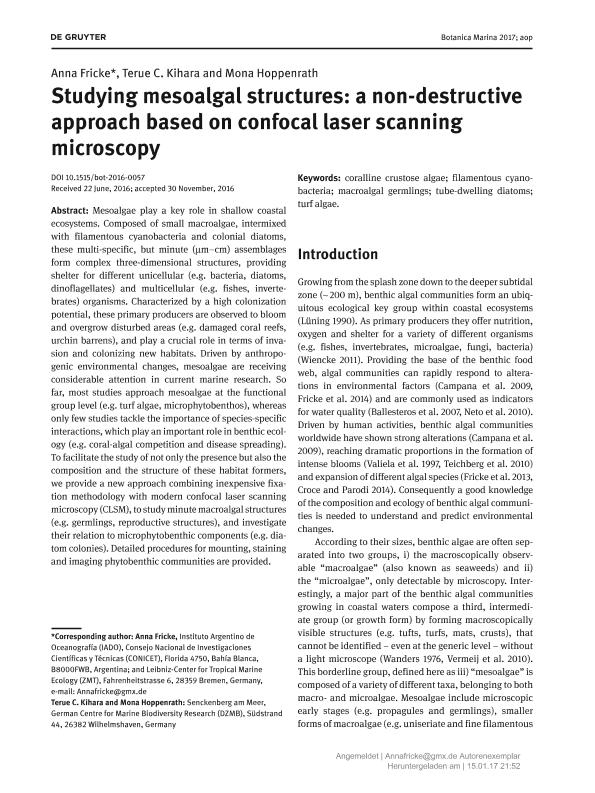Mostrar el registro sencillo del ítem
dc.contributor.author
Fricke, Anna Lena

dc.contributor.author
Kihara, Terue C.
dc.contributor.author
Hoppenrath, Mona
dc.date.available
2018-02-28T14:00:21Z
dc.date.issued
2017-04
dc.identifier.citation
Fricke, Anna Lena; Kihara, Terue C.; Hoppenrath, Mona; Studying mesoalgal structures: A non-destructive approach based on confocal laser scanning microscopy; De Gruyter; Botanica Marina; 60; 2; 4-2017; 181-195
dc.identifier.issn
0006-8055
dc.identifier.uri
http://hdl.handle.net/11336/37381
dc.description.abstract
Mesoalgae play a key role in shallow coastal ecosystems. Composed of small macroalgae, intermixed with filamentous cyanobacteria and colonial diatoms, these multi-specific, but minute (μm-cm) assemblages form complex three-dimensional structures, providing shelter for different unicellular (e.g. bacteria, diatoms, dinoflagellates) and multicellular (e.g. fishes, invertebrates) organisms. Characterized by a high colonization potential, these primary producers are observed to bloom and overgrow disturbed areas (e.g. damaged coral reefs, urchin barrens), and play a crucial role in terms of invasion and colonizing new habitats. Driven by anthropogenic environmental changes, mesoalgae are receiving considerable attention in current marine research. So far, most studies approach mesoalgae at the functional group level (e.g. turf algae, microphytobenthos), whereas only few studies tackle the importance of species-specific interactions, which play an important role in benthic ecology (e.g. coral-algal competition and disease spreading). To facilitate the study of not only the presence but also the composition and the structure of these habitat formers, we provide a new approach combining inexpensive fixation methodology with modern confocal laser scanning microscopy (CLSM), to study minute macroalgal structures (e.g. germlings, reproductive structures), and investigate their relation to microphytobenthic components (e.g. diatom colonies). Detailed procedures for mounting, staining and imaging phytobenthic communities are provided.
dc.format
application/pdf
dc.language.iso
eng
dc.publisher
De Gruyter

dc.rights
info:eu-repo/semantics/openAccess
dc.rights.uri
https://creativecommons.org/licenses/by-nc-sa/2.5/ar/
dc.subject
Coralline Crustose Algae
dc.subject
Filamentous Cyanobacteria
dc.subject
Macroalgal Germlings
dc.subject
Tube-Dwelling Diatoms
dc.subject
Turf Algae
dc.subject.classification
Otras Ciencias Biológicas

dc.subject.classification
Ciencias Biológicas

dc.subject.classification
CIENCIAS NATURALES Y EXACTAS

dc.title
Studying mesoalgal structures: A non-destructive approach based on confocal laser scanning microscopy
dc.type
info:eu-repo/semantics/article
dc.type
info:ar-repo/semantics/artículo
dc.type
info:eu-repo/semantics/publishedVersion
dc.date.updated
2018-02-19T16:59:01Z
dc.journal.volume
60
dc.journal.number
2
dc.journal.pagination
181-195
dc.journal.pais
Alemania

dc.description.fil
Fil: Fricke, Anna Lena. Zentrum Fur Marine Tropenokologie Bremen; . Consejo Nacional de Investigaciones Científicas y Técnicas. Centro Científico Tecnológico Conicet - Bahía Blanca. Instituto Argentino de Oceanografía. Universidad Nacional del Sur. Instituto Argentino de Oceanografía; Argentina. Leibniz Zentrum für Marine Tropenforschung; Alemania
dc.description.fil
Fil: Kihara, Terue C.. Senckenberg am Meer. Deutsches Zentrum für Marine Biodiversitätsforschung; Alemania
dc.description.fil
Fil: Hoppenrath, Mona. Senckenberg am Meer. Deutsches Zentrum für Marine Biodiversitätsforschung; Alemania
dc.journal.title
Botanica Marina

dc.relation.alternativeid
info:eu-repo/semantics/altIdentifier/doi/http://dx.doi.org/10.1515/bot-2016-0057
dc.relation.alternativeid
info:eu-repo/semantics/altIdentifier/url/https://www.degruyter.com/view/j/botm.ahead-of-print/bot-2016-0057/bot-2016-0057.xml
Archivos asociados
